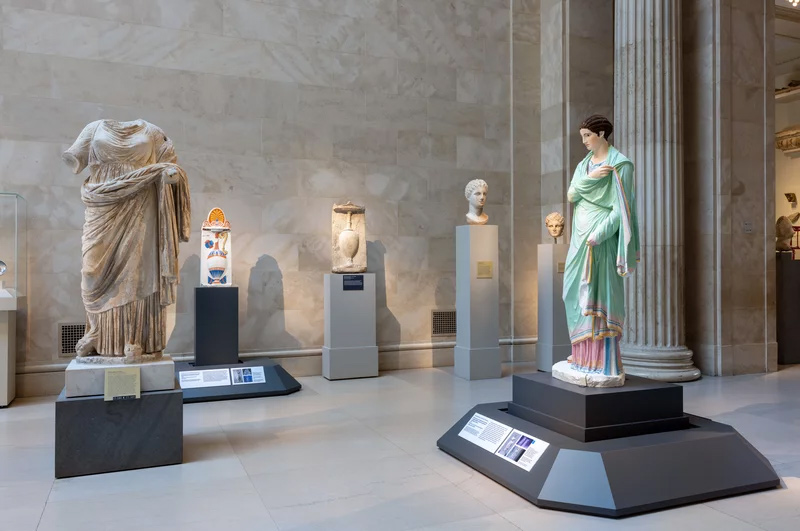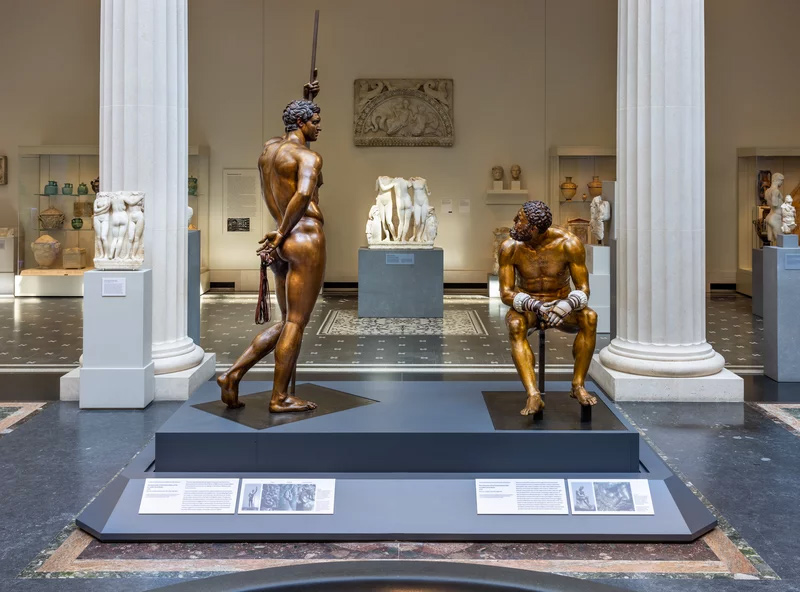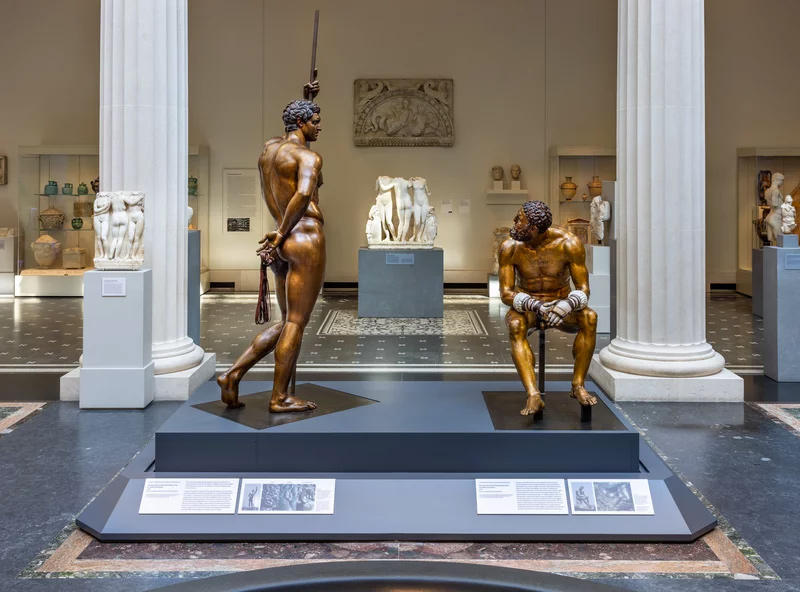 VIEW LARGER This reconstruction of a marble archer shows the vivid colors that characterized Greek sculpture, and patterns that identify him as a fighter from Persia.
VIEW LARGER This reconstruction of a marble archer shows the vivid colors that characterized Greek sculpture, and patterns that identify him as a fighter from Persia. Walk through the Greek sculpture galleries of most museums and you'll see pedestal after pedestal of white, marble statues with sightless eyes. That's just how Ancient Greek sculpture was, right?
Nope.
A new exhibit at the Metropolitan Museum of Art in New York scatters recreations of what these statues ACTUALLY looked like throughout its galleries: they're painted in garish colors with multiple patterns.
"For some, it will be a shock," said Max Hollein, the director of the museum. "But one has to understand that our current, whitewashed idea of Greek and Roman antiquity is wrong. It's false."
 VIEW LARGER In the galleries, colorful, reconstructed pieces are placed near similar, more familiar originals of white marble.
VIEW LARGER In the galleries, colorful, reconstructed pieces are placed near similar, more familiar originals of white marble. The knowledge that the Greek and Roman sculpture was brightly painted isn't new. In one gallery, there's a watercolor of parts of the Acropolis when it was excavated in 1888 - it's clear that the architectural segments came out of the ground vibrantly colored. And in museums around the globe, hints of color remain on statues from antiquity.
Yet somehow, that knowledge was lost. Vinzenz Brinkmann, Head of the Department of Antiquity at the Liebieghaus Sculpture Collection in Frankfurt am Main, said when he first started researching polychromy 40 years ago, "no one had interest in this for years, no one collected the clearly visible evidence. Except for me. I collected the evidence like a stamp collection."
Brinkmann and his wife, archeologist Ulrike Koch-Brinkmann, researched their reconstructions using photographic and spectroscopic technology. They also looked at as many ancient works of art in collections around the world as they could get their hands on.
YouTube
One of the pieces they're proudest of is a reconstruction of a sphinx in the Met's collection. Commissioned in about 530 B.C. by the parents of a young man who had died, the sphinx was originally placed high on a pedestal.
"Color conveys a lot of information, and when you see it from a distance, it really helps to identify different features," said Seán Hemingway, lead curator of the Met's Greek and Roman Art department. "Also, a lot of these sculptures were outside, and in Greece with that very strong, bright Mediterranean sun, you need those bright colors because they get muted a little bit, they get washed out."
The Greeks were great storytellers, Hemingway said. And these sculptures were often set in temples to the gods or as memorials. When people saw them, they would have immediately understood the different threads of story and myth they allude to. "Like the sphinx, which is the guardian figure. There's that famous story of the sphinx at the crossroads and having to answer the questions — that sphinx stood on a column, too. So anyone who saw this sphinx would have thought about this dangerous creature that can kill you and can speak to you."
 VIEW LARGER This sphinx is a reconstruction of one of the museum's masterpieces.
VIEW LARGER This sphinx is a reconstruction of one of the museum's masterpieces.
The reconstructed sphinx is placed near the original sphinx, where visitors can see smudges of color on the figure's body. The 17 Greek and Roman reconstructions are placed near similar pieces in the galleries, and stretch from the early bronze age to the second century AD. They include two bronze figures caught in the moment after a boxing match, with the wounds painted red and the eyes so realistic that one could imagine they are actually looking at each other.
 VIEW LARGER These bronze figures may tell the story of a local king who was defeated by a son of Zeus in a boxing match.
VIEW LARGER These bronze figures may tell the story of a local king who was defeated by a son of Zeus in a boxing match. The Greeks learned artistic techniques from Egypt, Mesopotamia and Asia. "At the final point in this evolution, they learned how to deceive the human eye," Brinkmann said. "We know from written sources that bronze sculptures of this period were perceived as super-realistic, Often people reached those statues in Greek sanctuaries and didn't know exactly — is this talking to me? Will this stand up? Or is it just bronze?"
Chroma will be on view at the Metropolitan Museum of Art through March 2023.

By submitting your comments, you hereby give AZPM the right to post your comments and potentially use them in any other form of media operated by this institution.